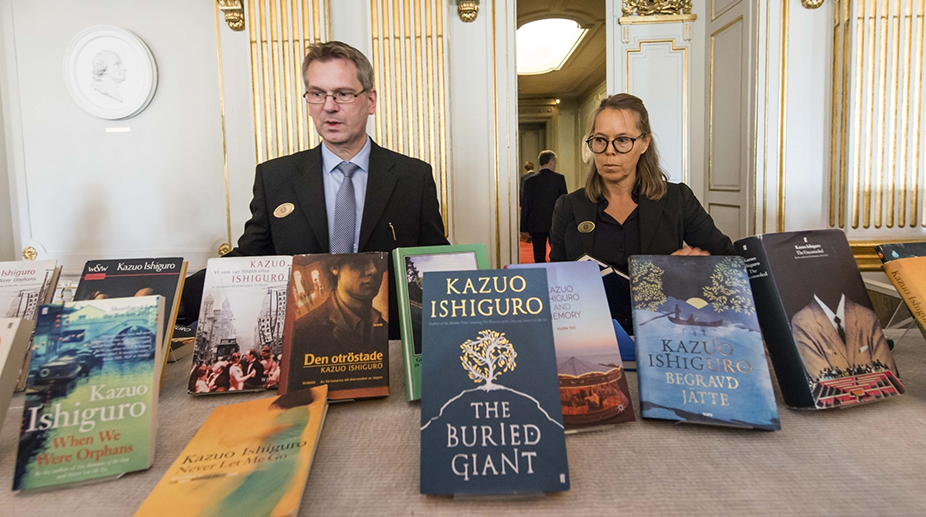A living example that literary art has no national landscapes or limitations, Japanese-born British writer Kazuo Ishiguro, the 2017 Nobel Literature laureate, is possibly its first recipient whose range of evocative works is not in his mother tongue and deals with situations and settings from far beyond his old and new homelands and times.
Spanning reminiscences of high life in the turbulent 1930s through the eyes of an English country house butler in the acclaimed Booker-winning “The Remains of the Day” (1989), the question of personal guilt a painter-turned-propagandist confronts in post-war Japan in “Artist of the Floating World” (1986), or other works set in Europe, colonised China, Arthurian Britain or in a dystopian future, Ishiguro’s small corpus is distinguished by its variety as well as some customary motifs and style.
Advertisement
The narration in all but one of his seven books is in first person, and the works usually deal with the past of the protagonists. As he noted in an interview, he was more “interested in memory because it’s a filter through which we see our lives, and because it’s foggy and obscure, the opportunities for self-deception are there. In the end, as a writer, I’m more interested in what people tell themselves happened rather than what actually happened”.
Then the endings are never cut and dried, with the protagonists gradually revealing their failings but without clearly stating they’re even aware of them, and thus ending up resigned to their inability to fully comprehend or change their lot in life.
It is possibly this sentiment of a gradual, and even nostalgic, alienation which the Swedish Academy cited as it lauded Ishiguro for having “uncovered the abyss beneath our illusory sense of connection with the world” in his “novels of great emotional force”.
While “The Remains of the Day”, about the dignified and proper butler pondering over his past and wondering about his future after a life completely devoted to the service of another person, remains Ishiguro’s most famous — perhaps after its 1993 film adaptation — his other books also deal with this motif in unusual ways.
A personal favourite would be the surrealistic, dreamlike — and much panned by baffled critics and readers — “The Unconsoled” (1995). It is the story of concert pianist Ryder’s visit to an unnamed Central European city for a performance, where he finds himself besieged by people he has no recollection of, accosting him with a raft of appointments and promises he has no memory of or can possibly fulfill in his brief stay.
Then there is his darkly dystopian “Never Let Me Go” (2005) which memorably combines the British boarding school tale tradition with the commoditisation of the human body.
Author and columnist Kiran Manral, who has a pretty varied range of books herself, says what marks Ishiguro out is the focus on “the individual placed at the centre around which the universe and its chaos unfolds”.
Confessing to being a Ishiguro fangirl since reading “Never Let Me Go”, she admits it “still haunts her”, but also “made me realise the immutability of an ending which did not have a conclusion”.
Born in Nagasaki in 1954, Ishiguro grew up in England where his family moved in 1959, and began writing after doing his Masters in 1980. His first work, “A Pale View of the Hills” (1982), came out the same year in which he himself became a British citizen.
While his first two works have Japanese themes, “A Pale View..” was an indicator of his craft and vision. Though dealing with a Japanese woman discussing the suicide of her eldest daughter with her younger child, it takes place in England where the older woman is living. “Artist…”, his second book, is set in an unnamed town in post World War II Japan, but then came “Remains…” which cemented Ishiguro’s position.
After “The Unconsoled”, came “When We Were Orphans” (2000), termed a detective story with the protagonist, who lived in the Shanghai International Settlement in the early 1900s till both his parents disappeared, returning there in the late 1930s to investigate their disappearance. It was not very well received and even he admitted it was not one of his best.
There was a long hiatus after “Never Let Me Go”, but “The Buried Giant” (2015) literally broke new ground in substance and style, as well as its setting — a fantasy, post-Arthurian Britain.
And soon, Ishiguro may surprise us again.











